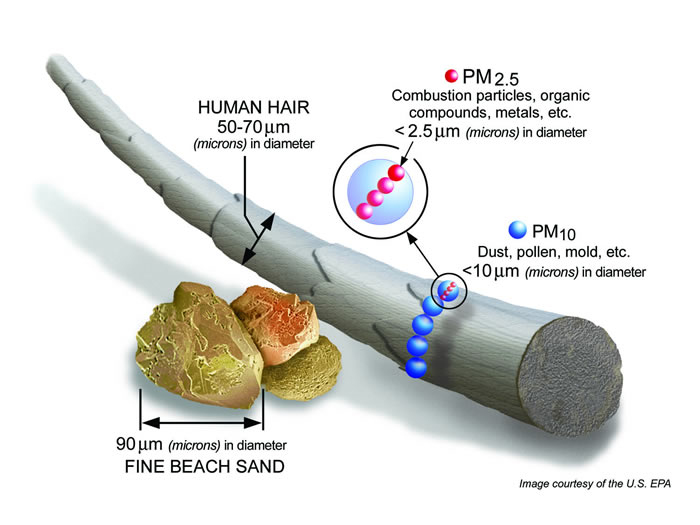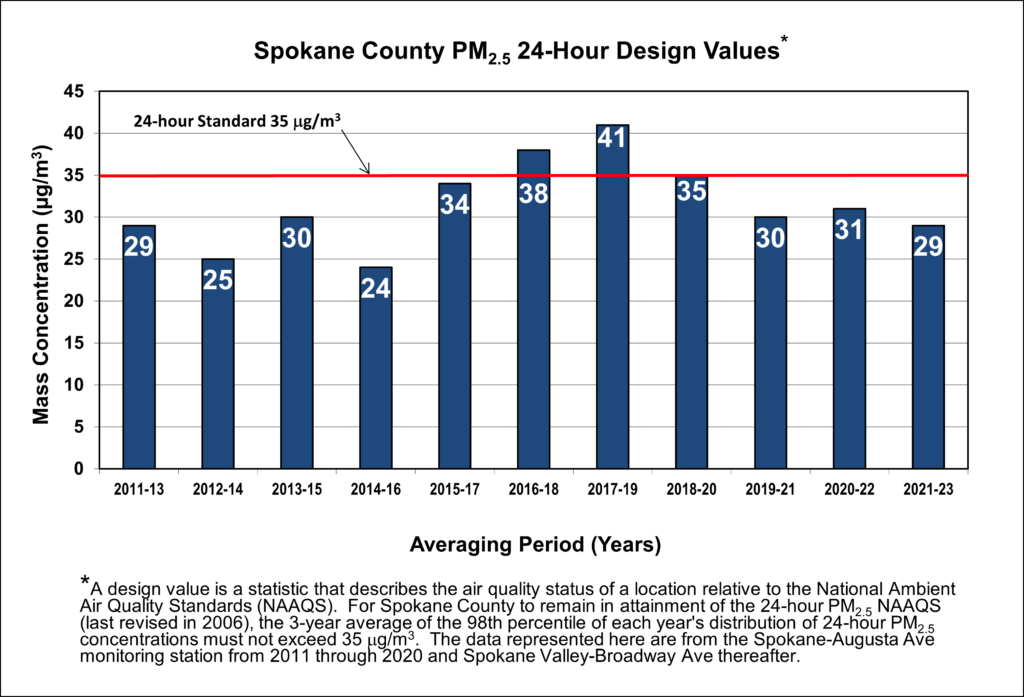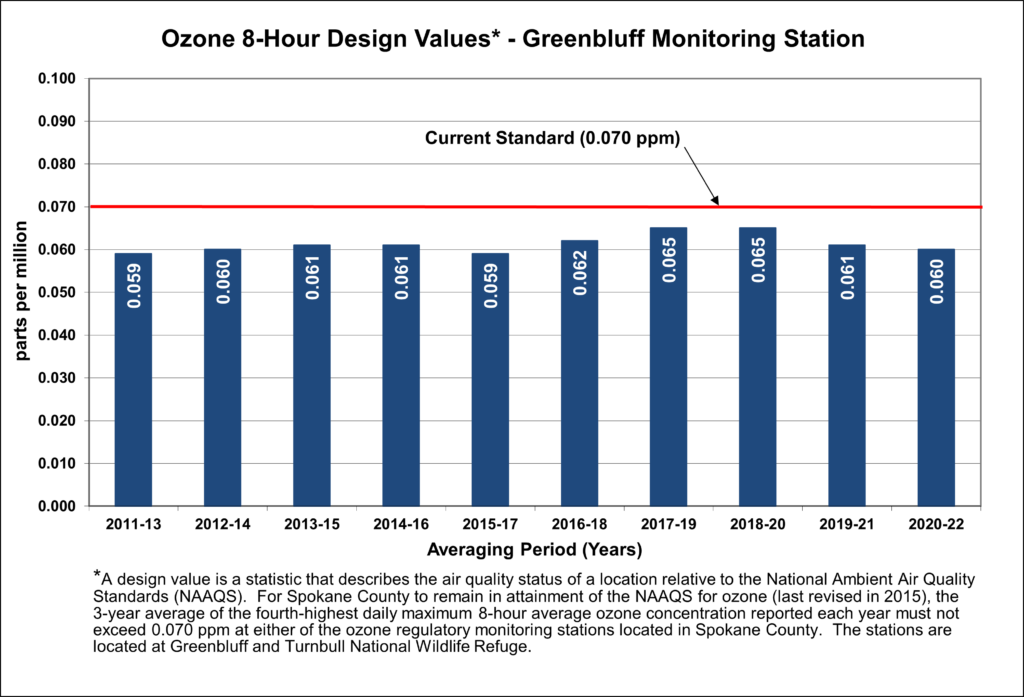Air pollutants of most concern
There are five air pollutants most-commonly found in the ambient (outdoor) air across our nation. Health-based standards for these pollutants, known as criteria air pollutants, are established by the U.S. Environmental Protection Agency (EPA). The standards are reviewed by EPA every five years and updated as necessary to ensure protection of public health and the environment.
Locally, there are three ambient air pollutants of primary concern: Fine and Coarse Particulate Matter (PM2.5 and PM10) and Ground-level Ozone (O3).
Particulate Matter
What is Particulate Matter and where does it come from?
Particulate Matter (PM) is mostly comprised of smoke and dust, depending on the size.
Fine particles (PM2.5) are 2.5 microns in diameter and smaller. These microscopic particles come mostly from combustion.
Coarse particles (PM10) are 10 microns in diameter and smaller, so they include larger particles such as dust.
Particle pollution in our area comes from a variety of sources, including:
- wood heating
- paved and unpaved roads
- wildfires
- construction-related activities
- till harvest dust
- non-residential outdoor burning
- residential outdoor burning
- on-road mobile sources
How does PM affect our health?
The size of particles is directly linked to their potential for causing health problems. Small particles less than 10 micrometers in diameter pose the greatest problems, because they can get deep into your lungs, and some may even get into your bloodstream.
Exposure to such particles can affect both your lungs and your heart. People with heart or lung diseases, children, and older adults are the most likely to be affected by particle pollution exposure. Numerous scientific studies have linked particle pollution exposure to a variety of problems, including:
- premature death in people with heart or lung disease
- nonfatal heart attacks
- irregular heartbeat
- aggravated asthma
- decreased lung function
- increased respiratory symptoms, such as irritation of the airways, coughing or difficulty breathing.

PM trends in our area
The health standard for both PM2.5 and PM10 is a 24-hour average, midnight to midnight.
PM2.5 standard is 35 micrograms per cubic meter of air, and PM10 is 150 micrograms per cubic meter of air.
This chart is a list of days when PM2.5 failed to meet the 24-hour federal, health-based standard, including the maximum daily AQI and the cause, dating back to 1999.
Below is a chart of Spokane’s PM2.5 trends.

What can you do to help reduce PM?
- Always check for burn restrictions before starting any fire.
- Heat with wood? Burn wisely by using only dry, seasoned firewood and providing plenty of air to avoid a smoky, smoldering fire. Always check burning conditions before you start your fire. More wood heating information.
- Use a broom instead of a leaf blower to clean sidewalks.
- Keep the dust down. If you have to drive on an unpaved road, please travel slowly.
- Indoor air quality can be affected by particles – learn ways to reduce particles in your home and improve indoor air quality. EPA’s Indoor Air Quality webpage.
Ozone
What is it? Where does it come from?
Ozone can be found in two locations – in the Earth’s upper atmosphere where it protects us from UV radiation. That same ozone at the Earth’s surface is referred to as ground-level ozone. It is a harmful air pollutant that poses a risk to human, animal and plant life.

Ground-level ozone is formed as a result of photo-chemical reactions between nitrogen oxides and volatile organic compounds in the presence of sunlight and heat. Ozone is only a concern during the hot, summer months when levels can pose a health concern.
Ozone-forming emissions come from many sources including motor vehicles, industrial solvents, gasoline refueling, gasoline-powered yard equipment, auto body paint shops, and consumer products such as charcoal lighter fluid, paints, etc.
How does Ozone affect our health?
Even at low concentrations, ozone causes respiratory problems and aggravates asthma in children. People with respiratory diseases and those who work or exercise outside should limit their time outdoors on hot, sunny days when ozone levels are likely to be elevated.
Children are at higher risk from exposure to ozone because they are often active outside during the summer and their lungs are not fully developed. Long-term exposure to ozone may lead to premature aging of the lungs and chronic respiratory illnesses.
Ozone trends in our area

What can you do to help reduce Ozone?
- Reduce car trips by combining errands. Walk, bicycle or ride the bus once a week, instead of driving alone.
- Refuel in the evening. This keeps ozone-forming vapors out of the air during the heat of the day.
- Hold off using gas-powered lawn equipment until evening.
- Use manual or electric yard and garden tools instead of gas-powered tools.
- If you use a charcoal barbecue, start it with an electric probe instead of lighter fluid.
- Use low VOC paints and solvents.
How does our air compare to other U.S. counties?
This is a question we get asked a lot. The U.S. EPA has a webpage, AirCompare, with maps that provide information for counties that monitored outdoor air quality in the last five years. Information can be tailored for groups more likely to be affected by different levels of pollution.
How can I get involved in helping reduce air pollution?
Visit our Learning Center to find out ways you can help improve our air quality today!

